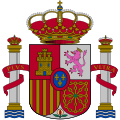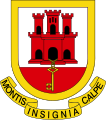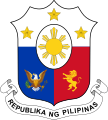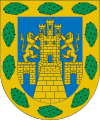| Coat of arms of Castile and León | |
|---|---|
 | |
| Armiger | Castile and León |
| Adopted | 1230 |
| Crest | A former royal crown (without arches, orb and cross) |
| Shield | Quarterly: 1 and 4 Castile, 2 and 3 León |
The coat of arms of the Spanish autonomous community of Castile and León depicts the traditional arms of Castile (the yellow castle) quartered with the arms of León (the purple lion). It is topped with a royal crown.
The lion design is attributed to Alfonso VII, [1] who became king of Castile and León in 1126. The castle symbol is attributed to his grandson Alfonso VIII, [1] In 1230, Ferdinand III united the two kingdoms and quartered the arms as a symbol of the union. [1] Until the sixteenth century, a full castle, with walls and three towers, rather than the current town design, was used. [2] Like Lyon in France, the name of the city of León has no link with the animal lion, as it comes from the Latin word legio ( legion).
Its original elements are used not only in the current autonomous community of Castilla y León, but also in the national coat of arms of Spain, in municipal arms like the coat of arms of Toledo and in coats of arms of many former territories which belonged to the Crown of Castile, such as Jaén or Los Angeles, California.
It also appears on the Catholic diocese coat of arms of Diocese of St. Petersburg, the Archdiocese of Santa Fe, Diocese of St. Petersburg and the Roman Catholic Archdiocese of Manila.
In history
-
16th century retrospective portrait of John of Gaunt (1340–1399), who claimed the Crown of Castile
-
Cristopher Columbus landing for first time in America
-
Seal of Sancho IV of Castile
Castile and León autonomous community
-
Coat of arms of Castile and Leon in Fuensaldaña castle, old head office of the Cortes of Castile and León
-
Coat of arms in a certificate of secondary studies issued by the regional government
In the world
-
Coat of arms of Los Angeles, California
-
Seal of the governor of Alabama
-
Seal of St. Johns County, Florida
-
Coat of arms of St. Augustine, Florida
-
Coat of arms of Philippines
-
Coat of arms of Panama City
-
Coat of arms of Carmen de Patagones, Argentina
-
Coat of arms of Laredo, Texas
-
Seal of El Cajon
See also
References
- ^ a b c Flag, emblem and coat of arms[ permanent dead link]. Junta de Castilla y León website. Accessed January 26, 2008.
- ^ http://flagspot.net/flags/es-cl_hi.html The flag at Flags of the World.




























